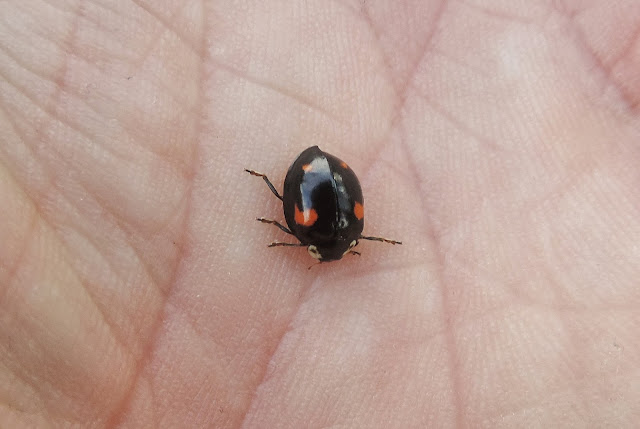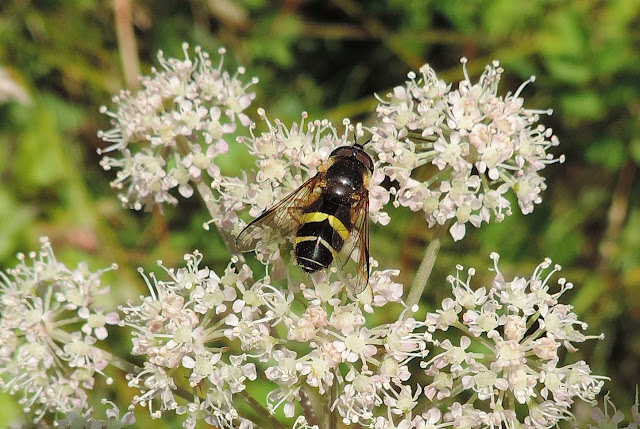Monday, 31 August 2015
Plenty of day feeding moths on Ragwort at Drysiog today
Anthophila fabricana
Dingy Footman
Ypsolopha parentsethella
Also seen were Bryotropha terrella and Cydia ulicetana. The Longhorn Beetle Stictoleptura rubra (male) and Larch Ladybird. As well as 16 species of previously recorded hoverflies.
Dingy Footman
Ypsolopha parentsethella
Also seen were Bryotropha terrella and Cydia ulicetana. The Longhorn Beetle Stictoleptura rubra (male) and Larch Ladybird. As well as 16 species of previously recorded hoverflies.
Bibionidae flies
The family "Bibionidae" or St Mark's Flies as they are commonly known contains 18 species - Bibio (14) and Dilophus (4). 14 species have been recorded in Wales of which 8 are in Glamorgan according to the NBN Gateway. The species below is Bibio pomonae who's English name is - The Heather Fly and seems to be quite common in the upper valley, where Heather grows although this one was feeding on Hogweed. I also recorded them feeding on Ragwort and the Butterfly Bush. The males have large eyes like this one, while the females eyes are very small, making them look like a different species. Bibio have spurs on the tibia where it joins the tarsi, while Dilophus does not. The leg pattern on this species is diagnostic for the males.
Sunday, 30 August 2015
Dexiosoma caninum @ Cwm Drysiog
Not a rare fly by any means. But it has not been recorded with regularity in Glamorgan - so worth a post, it is a member of the Tachinid family. Interesting fact about this species is that the adult female lays its eggs on the beetle Common Cockchafer or Maybug as it is better known.
Friday, 28 August 2015
Sericomyia silentis & Eristalis tenax
Diagnostic abdomen pattern of Sericomyia silentis
Thick hind femur and tibia and hair line on the eye diagnostic of Eristalis tenax within the family group
Thick hind femur and tibia and hair line on the eye diagnostic of Eristalis tenax within the family group
Thursday, 27 August 2015
Melangyna umbellatarum - another new hoverfly for Caerau
Very similar to the Melangyna compositarum/labiatarum, but the paler colour to the tergites [almost white] and the shiny black thorax are good indicators that this is umbellatarum. The diagnostic features though are the small black spot at the base of the scutellum and the amount of dusting on the frons which seperates it from similar species.
Monday, 24 August 2015
Sunday, 23 August 2015
Between the rains
Common Carder Bee
Common Carder Bee face shot
Digitvalva pulicariae
Gatekeeper
Field Grasshopper
Harlequin Ladybird - dark form
Common Carder Bee face shot
Digitvalva pulicariae
Gatekeeper
Field Grasshopper
Harlequin Ladybird - dark form
Friday, 21 August 2015
Day moths
Five-spot Burnet
Six-spot Burnet - with the extra spot near the end of wing compared to Five-spot Burnet
Six-spot Burnet - with the extra spot near the end of wing compared to Five-spot Burnet
Wednesday, 19 August 2015
Rare hoverfly @ Cwm Drysiog
Photographed this rare hoverfly at Cwm Drysiog, Maesteg on 7th August 2015 - "Eupeodes lapponicus". It took a while for experts to get back to me with confirmation. From the NBN Gateway map you can see that there has been only a few records in Britain. Although not fully up to date, it does show how rare this species is in Britain. There is a good chance that it is a Glamorgan first. The diagnostic feature is the strong dip in the R4+5 vein on the wing
Insects from today around Caerau
Hoverfly - Dasysyrphus trinctus
Hoverfly - Eupeodes luniger
Longhorn Beetle - Stictoleptura rubra
Butterfly - Red Admiral
Conopid Fly - Sicus ferrigineous
Hoverfly - Eupeodes luniger
Longhorn Beetle - Stictoleptura rubra
Butterfly - Red Admiral
Conopid Fly - Sicus ferrigineous
Subscribe to:
Comments (Atom)



































